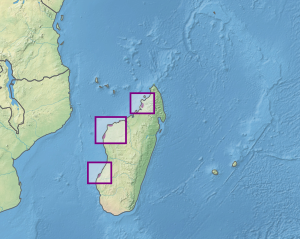Madagascar mangroves
| Madagascar mangroves | |
|---|---|

|
|
 |
|
| Ecology | |
| Realm | Afrotropic |
| Biome | Mangroves |
| Borders | Madagascar dry deciduous forests, Madagascar subhumid forests, Madagascar succulent woodlands, Madagascar spiny forests |
| Animals | green turtle, hawksbill turtle, dugong |
| Bird species | Madagascar heron, Madagascar fish eagle |
| Geography | |
| Area | 5,200 km2 (2,000 sq mi) |
| Country | Madagascar |
| Elevation | sea level |
| Coordinates | 17°1′S 44°12′E / 17.017°S 44.200°ECoordinates: 17°1′S 44°12′E / 17.017°S 44.200°E |
| Geology | river sediments |
| Climate type | Tropical monsoon climate (Am), hot semi-arid climate (BSh), and hot desert climate (BWh) |
| Conservation | |
| Conservation status | vulnerable |
| Global 200 | included |
The Madagascar mangroves are a coastal ecoregion in the mangrove forest biome found on the west coast of Madagascar. They are included in the WWF's Global 200 list of most outstanding ecoregions.
Mangrove swamps are located in flat coastal areas where the ocean tides wash salt water high into the mouths of rivers which are bringing nutrient-rich soil down to the coast. For mangroves to thrive there also needs to be some natural feature such as coral reefs to shelter the coast from ocean storms and the monsoons. In Madagascar they are mostly found on the more sheltered western, Mozambique channel coast, where they stretch along roughly 1,000 kilometres (620 mi) of coastline. The largest areas are in the estuaries of the Betsiboka River (in Bombetoka Bay near the city of Mahajanga), Besalampy, the Mahajamba and South Mahavavy river, and near Maintirano. The climate is warm all along the coast but more humid in the north.
The mangrove trees found in Madagascar are mainly Rhizophora mucronata, black mangrove (Bruguiera gymnorrhiza), Ceriops tagal, white mangrove (Avicennia marina), Sonneratia alba and Lumnitzera racemosa. Other species are Xylocarpus granatum and Heritiera littoralis.
...
Wikipedia
